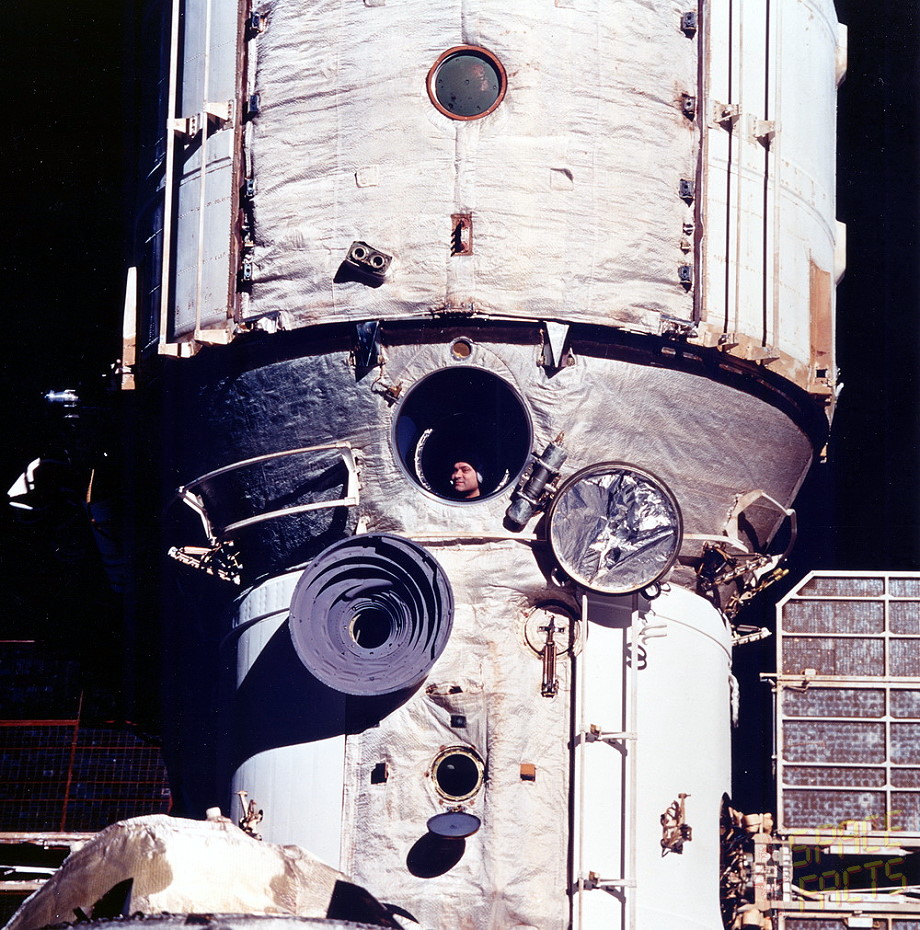
Twenty years ago, next week, in February 1995, the crew of Shuttle Discovery roared into the night on a mission which featured the first rendezvous with Russia’s Mir space station. During their eight days in space, the six-member STS-63 drew as close as 33 feet (10 meters) from the outpost which would shortly host several long-duration U.S. residents and support no fewer than nine shuttle dockings between June 1995 and June 1998. Yet the mission encompassed far more than that: scientific research within a pressurized laboratory in the orbiter’s payload bay, deployment and retrieval of a free-flying satellite, a lengthy EVA featuring the first African-American and British-born spacewalkers … and the first female pilot of the shuttle era.
When the STS-63 crew was announced by NASA in September 1993, they could hardly have expected that theirs would be a voyage of destiny. Scheduled for launch in May 1994, the five astronauts—Commander Jim Wetherbee, Pilot Eileen Collins, and Mission Specialists Bernard Harris, Mike Foale, Janice Voss, and Russian cosmonaut Vladimir Titov—were tasked with supporting a range of scientific and technical experiments inside the Spacehab-3 module and deploying and retrieving the SPARTAN-204 solar physics satellite. Collins had actually applied for both the pilot and mission specialist programs in 1989 and later acknowledged that both held equal fascination. “I think the reason NASA chose me as a pilot was due to all of my flying experience,” she explained. “Being chosen as a mission specialist would have been great, too. I would have had the opportunity to do spacewalks or work the robot arm. I would have learned more about the actual science of it. Both jobs really do have a lot to offer.”
All of Collins’ crewmates had prior spaceflight experience, perhaps none more so that Russia’s Vladimir Titov, who became only the second cosmonaut to fly aboard the shuttle. When he was named to join STS-63, Titov had six times as much experience as the rest of the crew, put together, having participated in the world’s first year-long piloted space mission between December 1987 and December 1988.
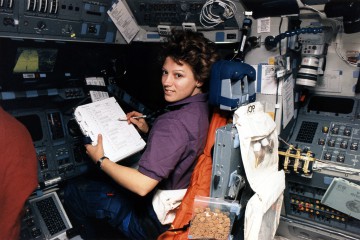
In June 1992, following the collapse of the Soviet Union, the United States and Russia issued a Joint Statement on Co-operation in Space, which defined plans for docking missions, at least one long-duration flight to Mir by a U.S. astronaut and several cosmonaut flights aboard the shuttle. Titov and fellow cosmonaut Sergei Krikalev were selected the following November as candidates, and in April 1993 Krikalev was assigned as prime crewman on STS-60, which eventually took place in February 1994. It thus came as little surprise when Titov drew an assignment to STS-63, although for the first few months it appeared to be little more than another Russian cosmonaut on another shuttle science mission.
The situation changed markedly in September 1993, when U.S. Vice President Al Gore and Russian Prime Minister Viktor Chernomyrdin chaired the inaugural meeting of the U.S.-Russian Joint Commission on Energy and Space, which produced a series of agreements and officially kicked off “Phase One” of the International Space Station (ISS) program and shuttle-Mir. Under its language, the two nations would execute up to nine shuttle docking missions, beginning in June 1995, and STS-63 was first identified as the flight which would perform a close-range rendezvous with Mir and test VHF radio communications and navigation hardware. The plan called for Wetherbee’s crew to guide the shuttle to a distance of 650 feet (200 meters) from Mir, although discussions had by this point been under discussion for several months.
As early as April 1993, Flight International explained that NASA was “considering” a shuttle-Mir rendezvous as a key preparatory step, ahead of the first docking mission. “The complexity … particularly the close proximity flying with the Mir—the largest object with which the shuttle has made rendezvous and one with several large solar arrays—has made NASA consider STS-63 a rehearsal mission,” it was noted.
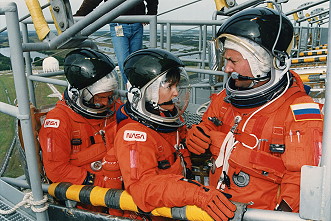
In assigning a Mir rendezvous, NASA was obliged to redesign the flight’s trajectory profile. Instead of launching into a standard 28.5-degree inclination, Discovery would fly into a 51.6-degree path, in order that it would enter the same orbital plane as the space station. However, by this time, STS-63 had been delayed from May 1994 until January 1995, due to a paucity of bookings for experiments aboard its Spacehab-3 module. In the months to come, experiments already manifested for the third and fourth Spacehabs were combined and produced a full plate of mainly NASA payloads on STS-63. “Spacehab’s position reflects the lack of interest in commercial microgravity processing,” Flight International explained, “which has been caused mainly by the high cost of experiments and the long-term nature of the research to develop viable processes.”
According to Jim Wetherbee, the original Mir rendezvous required him to approach the station no closer than 1,100 feet (330 meters), although U.S. and Russian trajectory planners eventually reduced this to 400 feet (120 meters) and finally just 110 feet (33 meters). However, for Wetherbee, this was impractical, since one of his goals was to test procedures, as well as the tracking radar and hand-held laser rangefinders. “All of these systems give range and range-rate information to the target—Mir, in this case—and the camera system that was going to optically give us information on the attitude misalignment by looking at the target,” he explained. “We were going to check out the procedures and the flight profile and the directions that we were approaching. The first thing that I noticed was that … the visual target that we used couldn’t be used accurately until we got to about 30 feet.”
Wetherbee was able to convince the NASA planners to accept a closure distance to just 33 feet (10 meters), getting Russian approval was a tougher nut to crack. “It resulted in a pretty interesting series of meetings and discussions about why we wanted to get so close to their station,” he said, “that is, of course, a national asset, like our shuttle. It was risky enough for them, for little benefit, since we weren’t actually going to dock and transfer any people.” Psychologically, it was difficult for the Russians to have the orbiter approach Mir so closely, with all effective control in the hands of the Americans. At length, when advised that the crew of the first shuttle-Mir docking mission, STS-71—commanded by Robert “Hoot” Gibson—would need to halt at 33 feet (10 meters) to make a visual assessment, before advancing closer, the plan produced approval.
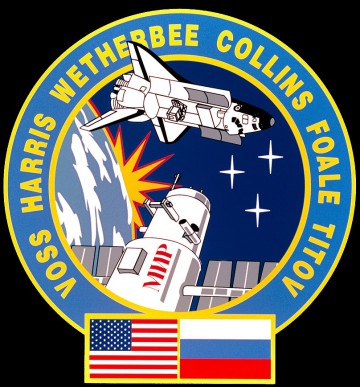
It was made clear by U.S. and Russian officials that Wetherbee was to approach no closer than that. “I was not going to violate that limit, by even a single centimeter,” he said, “because I knew both space agencies in both countries were going to be watching as we approached on this flight.” With Spacehab-3 payload problems having delayed STS-63 until January 1995, there would be a gap of just a few months before the first shuttle-Mir docking mission, which shortened the period of time for any lessons learned to be implemented in training simulations for the STS-71 crew.
By the dawn of 1995, the launch of Wetherbee’s mission had slipped until no earlier than 2 February. Russian planners insisted that the rendezvous had to occur whilst Mir was in contact with Russian ground stations, which demanded that the shuttle’s final approach had to occur during orbital darkness. “To make a daylight rendezvous would mean delaying for at least two weeks,” Flight International pointed out on 25 January, “which cannot be tolerated within the NASA shuttle schedule for 1995.” Although the rendezvous—which had earned the moniker “Near-Mir”—on Flight Day Four was the most publicly visible part of STS-63, the mission also featured 20 experiments aboard the Spacehab-3 module, whose flat roof carried a pair of 12-inch-diameter (30 cm) windows, one of which housed a NASA docking camera to assist with proximity operations.
Launch on 2 February was postponed by 24 hours, due to the failure of one of Discovery’s three Inertial Measurement Units (IMUs), which was replaced and tested. The launch window was particularly tight at just five minutes, and the precise launch time was decided relatively late in the countdown, based on new Mir state vectors for the shuttle rendezvous phasing requirements. These were updated about 60 minutes before launch, and the STS-63 crew rocketed away from Pad 39B at the Kennedy Space Center (KSC) at 12:22:03 a.m. EST on 3 February, turning night into day across the marshy Florida landscape.
Although Wetherbee was embarking on his third mission, he made sure to check on his rookie pilot, Collins, but need not have worried, for her performance was like that of a veteran. “As a commander flying with any rookie, you always want to see how they’re going to do,” he explained later, “and you can tell pretty much when they get in the vehicle that they’re going to be okay. During the liftoff, I could hear the things she was saying were just like we say in the sim. That was good.”
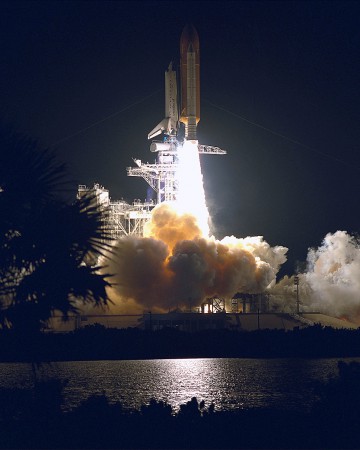
Within nine minutes, Discovery reached her preliminary orbit, although not without incident, for one of her aft-mounted Reaction Control System (RCS) thrusters failed and another exhibited a minor, but persistent leak. As soon as the External Tank (ET) was jettisoned, Wetherbee and Collins were alerted by a “Jet Leak” and two “Jet Off” RCS messages. The shuttle was equipped with 44 primary and backup RCS thrusters on its nose and aft compartment, which were required primarily for orbital maneuvering. Two aft-mounted thrusters had failed, one on the port side (L2D) and one on the starboard (R1U). The former was “deselected” and remained off for the rest of the flight, but R1U was a primary thruster and critical for the Mir rendezvous commitment.
Wetherbee was dismayed, having trained for more than a year to prepare for STS-71, to see his flight potentially hamstrung within minutes of achieving orbit. “As the day wore on, I was pretty much convinced that we were not going to be able to rendezvous with Mir,” he said, “and it was pretty disappointing.” Although all of the thrusters were fully redundant, flight rules dictated that all aft-firing RCS needed to be operational for the orbiter to advance closer than 1,100 feet (330 meters) from Mir. Later that afternoon, Mission Control asked Wetherbee to position the shuttle to allow the Sun to shine onto the vehicle’s top side and hopefully warm up the leaking thruster, which was losing up to 2 pounds (0.9 kg) of oxidizer per hour. This was less than originally feared, and its temperature of 12.2 degrees Celsius (53.9 degrees Fahrenheit) was stable and well above the minimum redline of 4.4 degrees Celsius (40 degrees Fahrenheit), although if it dipped significantly it would be shut down and any chance of approaching Mir within 1,100 feet (330 meters) would evaporate.
In the meantime, the crew pressed on with their mission. By the time the six spacefarers turned in for bed, Discovery was trailing the station by about 7,000 miles (11,250 km) and closing this distance by about (330 km) per orbit. Over the next three days, Wetherbee and Collins would execute five maneuvers to position the shuttle at a point about 46 miles (75 km) “behind” Mir, ahead of the final manual rendezvous. Bernard Harris activated the Spacehab-3 payloads—which included McDonnell Douglas’ Charlotte robot, capable of operating knobs, switches, and buttons, and exchanging experiment samples and data cartridges, thereby freeing up valuable crew time—and Vladimir Titov grappled SPARTAN-201 with Discovery’s Remote Manipulator System (RMS) mechanical arm for a series of observations of the “shuttle glow” phenomenon.
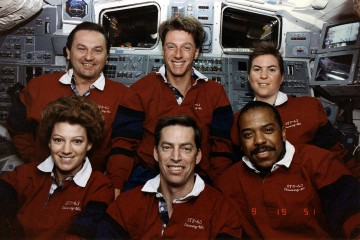
However, the RCS problems continued. The L2D aft thruster had been deselected, but its critical R1U counterpart maintained its minor leak. The problem worsened when one of the forward RCS thrusters in the shuttle’s nose (F1F) also began leaking during a two-part “hot-fire” test on 4 February. At one stage, its temperature fell below the minimum redline, forcing the crew to close its oxidizer supply line and maneuver Discovery into a nose-to-Sun orientation in an effort to warm it up. Efforts were also made to close and reopen its manifold, in the hope that the force of pressurization might push out any contaminants, and F1F was eventually revived.
The ailing R1U in the aft compartment was not so fortunate, however, with no fewer than four fruitless attempts made to bring it back online. By 5 February, the day before the Mir rendezvous, it was still leaking. “You could look out the back window and you could see the propellant going up for miles,” Wetherbee recalled. “It kind of goes in a cone-shaped pattern, because there’s no atmosphere to attenuate its motion, and it just goes up pretty straight and it just continues, like a snowstorm.” The risk of contaminating Mir was very real, not only in terms of the station’s fragile solar arrays, but also the delicate optical sensors of the Soyuz TM-20 spacecraft, which would ferry cosmonauts Aleksandr Viktorenko, Yelena Kondakova, and Valeri Polyakov back to Earth in late March.
Although the rendezvous to 33 feet (10 meters) was still officially on, Wetherbee remained uneasy. He pulled Vladimir Titov to one side. “You know, if this leak doesn’t get any smaller, I will not bring our vehicle close to Mir,” he told the cosmonaut, “even if they give us a ‘Go,’ because I don’t want to cause any problems for the cosmonauts when they’re coming back.” Indeed, 6 February 1995 would be a day of truth for both the shuttle, Mir, and the new partnership between the two nations.
The second part of this article will appear tomorrow.
Want to keep up-to-date with all things space? Be sure to “Like” AmericaSpace on Facebook and follow us on Twitter: @AmericaSpace



